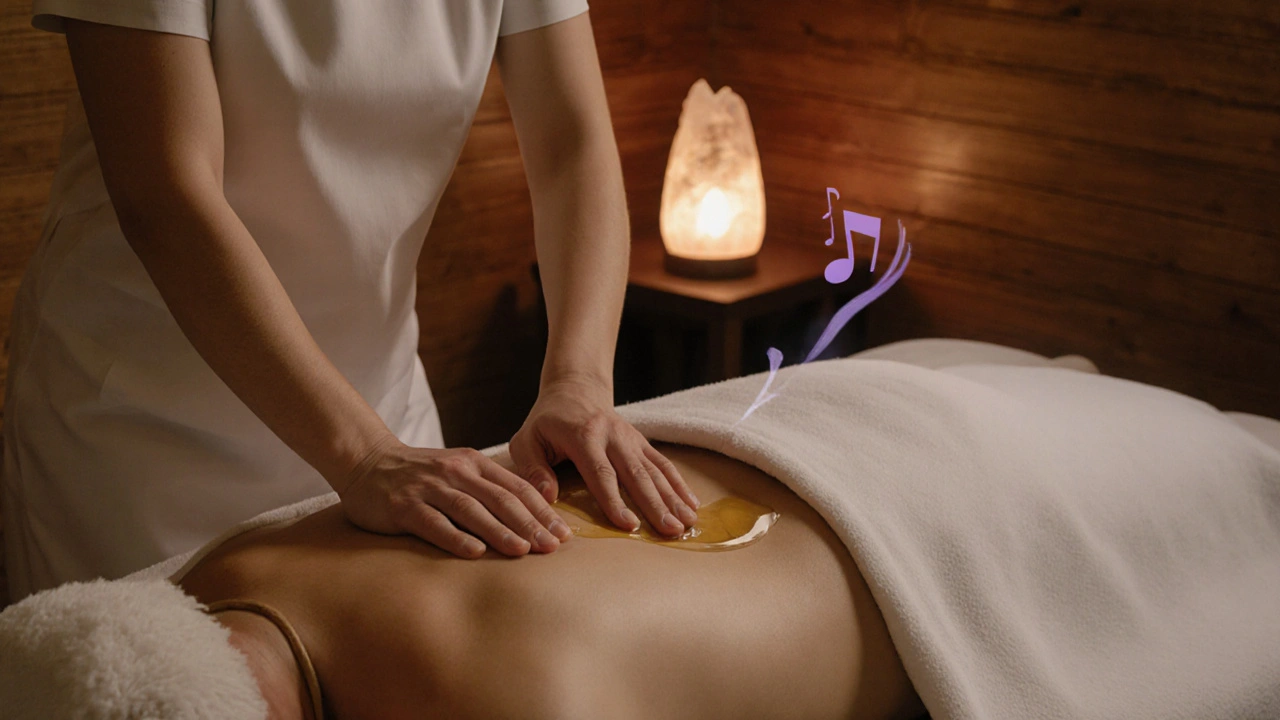Perfect Body Massage Routine for Busy People: Quick, Effective Tips

If your calendar barely gives you time to breathe, making room for relaxation can feel impossible. That’s where a quick, targeted body massage routine comes into play. You don’t need hours at a spa—you can refresh your mind and body in as little as ten minutes, right at home or during a break from work.
Even short massages can drop your stress levels, boost circulation, and help those stubborn knots finally disappear. Got a sore neck from hunching over a laptop or stiff shoulders after zoom calls? Massaging those spots with simple moves can actually make a difference, fast. Don’t worry about fancy oils or weird equipment; your hands and maybe a tennis ball will do the trick.
The secret isn’t about perfection—it’s about consistency and knowing a few go-to techniques. Let’s look at ways real people squeeze more calm into their jam-packed weeks, so you can actually stick to it—no special training required.
- Key Takeaways
- Quick-Start Massage Routine
- Smart Booking and Safety Tips
- FAQs: Massage for Busy Lifestyles
Key Takeaways
Squeezing a body massage routine into your busy life is easier than you think and doesn’t need to be complicated. Here’s what you really need to remember if you’re trying to add a little more self-care into your packed schedule:
- Even a quick 10-minute massage focused on tight areas like your neck, shoulders, or lower back can noticeably reduce stress and muscle tension.
- You don’t have to be a pro—basic techniques, like kneading and gentle pressure, can be just as effective for daily relief.
- Regular mini-massage sessions can boost blood circulation, which helps your body recover from the daily grind and may improve sleep quality over time.
- Simple tools lying around the house—like tennis balls or foam rollers—work great if your hands need a break.
- If you prefer professional help, many places now offer speedy, targeted treatments that fit into lunch breaks or after-work slots—some clinics even have online booking or apps so you can claim a spot in minutes.
- Always listen to your body. If you feel sharp pain or weird discomfort, take a break or adjust your technique. Safety and comfort come first, even with quick fixes.
The bottom line? You can get real benefits without giving up hours of your day, and small, regular steps add up fast when it comes to feeling good.
Quick-Start Massage Routine
Let’s get straight to it: fitting a regular body massage routine into your day doesn’t have to mean hours out of your schedule or booking weeks ahead. You can do a lot with ten to fifteen minutes and a bit of know-how. Here’s how you can actually make it happen, even on your busiest days.
Start with problem areas. For most people, that usually means the neck, shoulders, and lower back. Tension builds up fast if you spend a lot of time sitting or using screens, so these spots deserve attention.
- Neck and Shoulders: Use your fingertips to knead the muscles where your neck meets your shoulders. You can apply a bit of pressure in small circles. Do this for about one minute on each side. If you like, place a warm towel around your neck for extra comfort.
- Upper Back: Stand with your back to a wall and put a tennis ball between your back and the wall. Gently roll up and down, letting the ball hit those tight muscles. Spend two to three minutes here, focusing on areas that feel tense or sore.
- Lower Back: Sit upright in your chair and use your fists to massage the muscles on either side of your spine. Move in slow, steady circles, going for two minutes. Skip the spine itself and focus on the muscle.
- Hands and Forearms: These get tight from typing or texting. Squeeze the fleshy part of your palm and work your way up toward the wrist with firm but gentle pressure. Shake out your hands after one or two minutes.
- Finish with Deep Breaths: Before you jump back into your day, take three slow, deep breaths to lock in that relaxed feeling. This actually drops your heart rate and signals your body to chill.
If you want to level up, add a drop of simple massage oil or even use your favorite lotion—this helps your hands glide and prevents skin irritation. And if you find a spot that’s extra tender, don’t go harder. Instead, spend longer with gentle, slow movements. Sometimes less is more.
Experts say even a few minutes of massage can help lower stress hormones, improve sleep, and make you feel more energized. If you only do one thing, keep it consistent. Setting a reminder—like after lunch or before bed—can help make it stick. Your body will thank you for it every time.

Smart Booking and Safety Tips
When your life is already non-stop, booking a massage should be the easiest part. These days, most good massage services let you book online or even through an app. Look for spots with clear reviews—Google and social media are your friends here. Real feedback usually tells you way more than a fancy website. If you’re using a booking app, stick with well-known ones like Mindbody or Fresha. They partner with legit therapists and make scheduling a breeze.
Timing matters a lot. If you’re pressed for time, early morning or quick lunch-break slots can work wonders and don’t derail your day. Most places offer express options, too—think 30 minutes focused on your neck and shoulders instead of a full-body marathon.
Now on to the safety stuff. This part isn’t boring—it keeps you protected. Only ever book with licensed therapists. In the U.S., massage therapists need state certification, so check if that’s listed. If you’re in Europe or elsewhere, every country has its own rules, but professional therapists should never mind showing proof if you ask. Don’t be shy—your comfort comes first.
- If you have health issues like heart problems, diabetes, or you’re pregnant, always talk to your doctor first.
- Be upfront about injuries or sensitivities so the massage therapist can avoid risky spots.
- Avoid massage if you’ve got a fever or skin infection.
- After your session, skip super-heavy meals and hydrate with water to help your body flush out toxins.
If you try self-massage at home, start light. Avoid bruising or pressing too hard, especially on your lower back or neck. Always listen to your body—any sharp pain means stop right there.
Keeping these body massage routine tips in mind helps you relax without worry and get real results, even when your day is packed.
FAQs: Massage for Busy Lifestyles
People with packed schedules have lots of questions about getting enough massage to make a difference. Here’s what comes up the most.
Q: How short can a massage session be and still work?
A ten-minute massage can actually do a lot. According to a report by the American Massage Therapy Association, sessions as short as 10-15 minutes can noticeably reduce stress and muscle tension. You don’t have to block off your whole afternoon—just enough time for a break makes a difference.
Q: What areas should I focus on if time is tight?
Stick with your trouble spots: neck, shoulders, lower back, and sometimes feet if you’re on them all day. These areas store tension, and even a quick massage can offer relief.
Q: Do I need tools or can I just use my hands?
Your hands work fine for most routines, but things like massage balls or rollers can save time. For your back or shoulders, lying on a tennis ball and rolling gently can target knots in sixty seconds.
Q: Can I get the same benefits from self-massage as from a professional?
You might not get the spa experience, but research shows self-massage still helps with muscle soreness and stress. Plus, you can do it more often—perfect for anyone with a full calendar.
Q: How often should I use my body massage routine?
This one is easy! Aim for a quick session two or three times a week. Studies suggest people who regularly use self-massage routines report lower stress levels and fewer headaches.
| Session Length | Reported Stress Reduction (%) | Muscle Soreness Relief (%) |
|---|---|---|
| 10 minutes | 37% | 28% |
| 20 minutes | 49% | 48% |
| 30 minutes | 57% | 54% |
Q: Is there a best time of day for a body massage routine?
There’s no magic hour, but lots of folks find it helps either first thing in the morning to wake up or at night to unwind. Try it at different times and notice when it works best for you.
Q: Will a quick routine help with sleep?
Yes—if you squeeze in a short massage before bed, you might fall asleep faster and sleep more soundly. One small study even found that ten minutes of self-massage can help lower nighttime anxiety and make it easier to drift off.
Got a tight schedule? Even the busiest people can fit in a body massage routine—and your body (and mind) will thank you for it.

